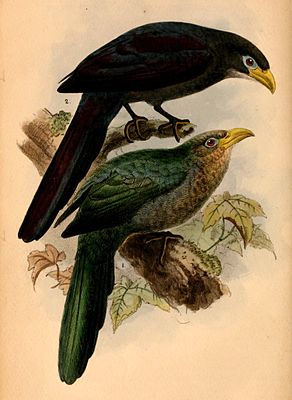Western cuckoo
| Western cuckoo | ||||||||||
|---|---|---|---|---|---|---|---|---|---|---|

Western cuckoo ( Ceuthmochares aereus ) behind. In front the Easter cuckoo belonging to the same genus |
||||||||||
| Systematics | ||||||||||
|
||||||||||
| Scientific name | ||||||||||
| Ceuthmochares aereus | ||||||||||
| ( Vieillot , 1817) |
The western cuckoo ( Ceuthmochares aereus ) is a species from the family of cuckoo birds, which belongs to the so-called ore cuckoos . It is a medium-sized cuckoo that occurs exclusively in western Africa and is a resident bird in most of its range. The Easter cuckoo was previously classified as a subspecies of the Westerz cuckoo , but has been classified as a separate species since 2005.
Unlike many species within the cuckoo, the western cuckoo is not a brood parasite, but rather raises its offspring itself. The species is classified as not endangered by the IUCN because of its large distribution area.
features
The Westerz cuckoo reaches a body length of 33 centimeters. The control springs account for around 20 centimeters. The strong beak measures around 2.4 centimeters. Males weigh an average of 62 grams, the females are slightly heavier and weigh 68.5 grams.
There is no noticeable gender dimorphism : In the nominate form , both males and females have a dark green skull and neck. The rein, d. H. the region between beak and eyes is greenish gray. The back, the wings, the upper tail covers and the control feathers are shiny dark gray. The chin and throat are medium gray. The chest is gray, the belly is also gray and turns black at the lower abdomen. The long control springs are shiny purple on the underside.
The iris is red or chestnut brown, in young birds it is brown. The eyelid ring is yellow and turns green in front of the eye. The strong beak is bright yellow and turns black, especially at the base of the beak. The legs are black.
Young birds are similar to the adult birds, but are generally duller in color. On the top of the body they are soot-colored. The chest is dark gray with brownish feathers.
distribution
The western cuckoo is an afrotropic species. Its range extends from the coast of Senegal, Gambia and Guinea to Uganda and in the south of Sudan, western Kenya and northwestern Tanzania. It also comes in northern Angola, Gabon and Equatorial Guinea.
The Westerz cuckoo is a resident bird in most of its range. In Nigeria, parts of the population move north during the rainy season.
habitat
The western cuckoo prefers to stay in secondary and gallery forests , which are surrounded by other forest types. It is particularly common on the edge of clearings. It is also found in acacia thickets along rivers and dry thorn bushes in Ethiopia.
It occurs in western Cameroon up to an altitude of 1600 meters. Further east it can still be found at an altitude of 2000 meters.
Way of life
The Westerz cuckoo is a secretly living bird that usually hovers in the thick foliage of tree tops. It finds its food mainly in the tops eight to 30 meters above the ground. It mainly eats caterpillars, including, like many other cuckoos, very hairy caterpillars, which are avoided by most other bird species. It also eats flying termites, beetles, bees, cockroaches, spiders, snails and tree frogs, and occasionally small birds. It also eats fruits, seeds and leaves.
Little is known about the breeding of the western cuckoo. It is assumed that Western cuckoos are monogamous and defend a territory. No specific period of reproduction can be identified in tropical Central and West Africa. Brooding western cuckoos can be found all year round. The nest is a loose platform made of leafy branches, which is usually set up two to five meters above the ground in a fork of branches. The clutch usually consists of two eggs, in rare cases up to four eggs. They are white to cream in color. So far nothing is known about the development of the nestlings and young birds.
Duration
The Westerz cuckoo is a common bird in parts of its range. In Gabon there are around 15 to 20 pairs per square kilometer. The western cuckoo is also a comparatively common bird in southeastern Nigeria.
Subspecies
The following subspecies are described for the western cuckoo:
literature
- Johannes Erhitzøe, Clive F. Mann, Frederik P. Brammer, Richard A. Fuller: Cuckoos of the World . Christopher Helm, London 2012, ISBN 978-0-7136-6034-0 .
Web links
Single receipts
- ^ Robert B. Payne: The Cuckoos . Oxford University Press 2005. (Bird Families of the World No. 15) ISBN 0198502133 .
- ↑ IUCN: Westerzkuckuck , accessed on August 17, 2016
- ↑ a b c d Erhitzøe, Mann, Brammer, Fuller: Cuckoos of the World . P. 235.
- ↑ a b c Erhitzøe, Mann, Brammer, Fuller: Cuckoos of the World . P. 236.